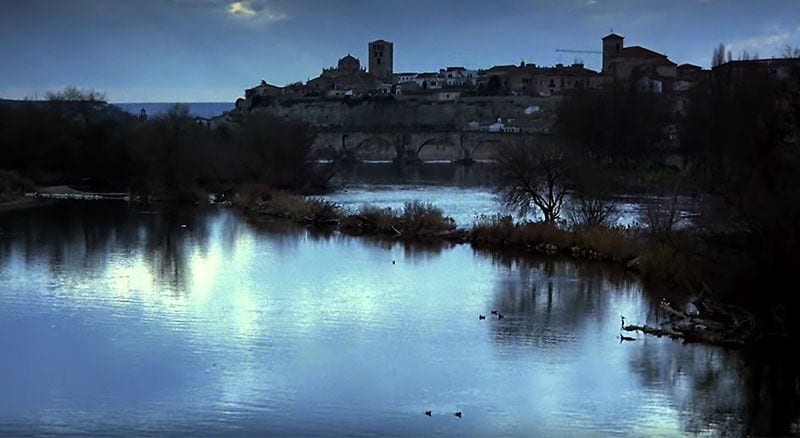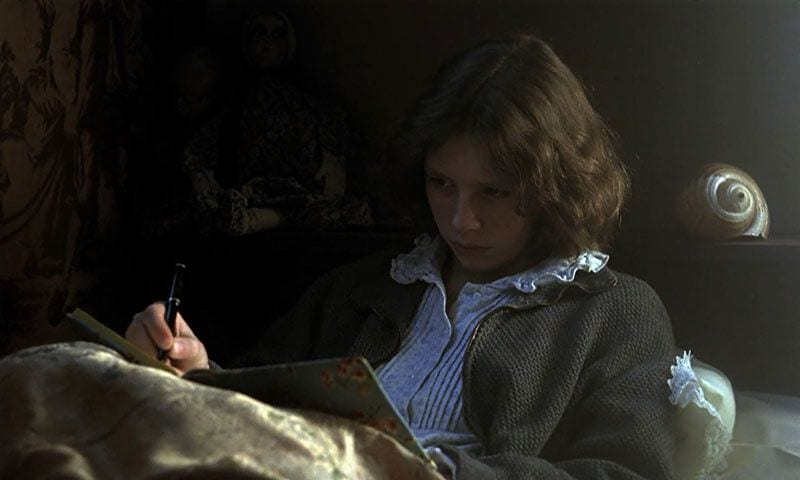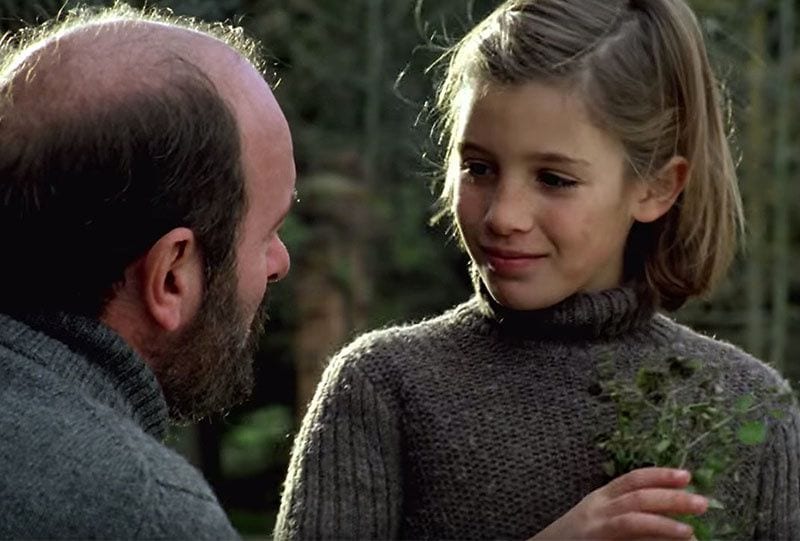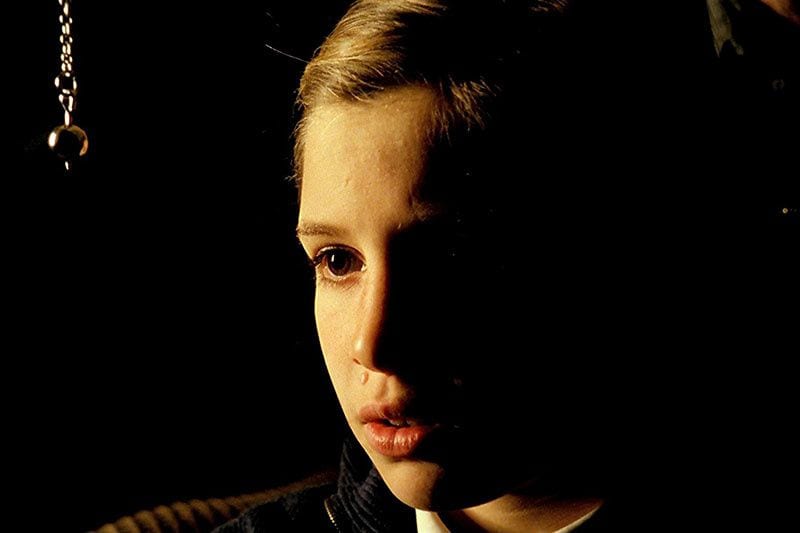
Víctor Erice‘s El Sur (“The South”, 1983), shimmers and quivers like the cinematic jewel it is, or like the brilliantly flashing silver star on the heroine’s ring finger. So it’s distressing and almost anti-climactic to realize that it’s an unfinished film. Perhaps it’s better for the viewer never to know this, but then we’d have to avoid all writings and discussions and interviews, as included on this Criterion Blu-ray. In the end, we must console ourselves with a work whose haunting near-perfection becomes the source of its perfection.
The basic elements of the story are simple, even if their effect isn’t. The entire film is narrated as the memory of an adult woman, Estrella (voiced by uncredited Maria Massip), who recalls two specific periods in her childhood, when she was eight and 15. She’s 15 (and played by Icíar Bollaín) when the film opens in what’s labeled “Autumn 1957”, and she awakens to the sounds of a dog barking distantly and her mother’s voice calling out for her husband Agustín, the girl’s father. In the half-light from the window, Estrella finds her father’s golden pendulum in a box under her pillow, and her narrating voice says that she knew her father would never return this time.
One could write a whole story about this scene alone, which right away intrigues the viewer with mystery, the ache of loss, a touch of the magical and sinister, and the shadows of a bygone era. “Shadows” must be understood literally, for the photography by José Luis Alcaine is one of the film’s aesthetic glories and would be worthy of its own coffee-table book. It’s no exaggeration to say that virtually every shot is a ravishing wonder that plays with light and shadow in exquisite increments, inciting obvious comparisons to Rembrandt, Velázquez and Vermeer in its manner of posing people in light sources. Yet these images live and move, thanks to the passage of time within them or to the occasional grace of dollies and traveling shots that bring us fully into the evanescence of memory.

In an interview, Alcaine says Erice was surprised by his tonal choices when he first saw the rushes, and compared it with the films of Eric Rohmer. Erice’s own interview states that he wanted this first part of the film, set in Northern Spain, to be subdued and autumnal and wintry, as a kind of darkling splendor, so as to contrast with the explosion of color when the story moves to Seville in the South — the part never filmed.
Erice and Alcaine’s collaboration was detailed and intimate, as witness the composition in the scene, for example, where Estrella writes in her diary as her voiceover discusses this diary. Directly to the right of Estrella’s concentrating face is a large seashell, about the size of her head, whose elegant earth-toned fractal seems to symbolize the function of memory spiraling inside her brain as she writes her cursive secrets, just as we associate such shells with the distant roar of the sea that calls its unknowable secrets to the ear.

“Shadow” (“sombra”) is a key word in the film in literal and metaphorical ways. One of many striking shadow scenes involves the father emerging like a spectre from the endless black at the back of the church as Estrella runs toward him in her equally spectral white dress. Another scene at a movie theatre involves a fictional film within the film, whose title means “The Flower in Shadow”, as we watch a clip from a pastiche of the era’s black and white Spanish melodramas.
The fictional film’s title may refer metaphorically to Estrella as the gawky, gangling blossom whose life is yet in shadow and which will later be recalled under memory’s shadow, and all of this means that Estrella is being subliminally identified with the film actress who holds the father spellbound in the dark. Later, at the same theatre, Estrella sees a similar poster for Alfred Hitchcock’s Shadow of a Doubt (1943), which also focuses on a teenage girl who glimpses the world of adult secrets. Thus do films speak to each other, overtly and subtly.
Meanwhile, life in 1950s Spain carried on under the twin shadows of history and of the dictator Francisco Franco, the living emblem of Fascist victory in the Spanish Civil War that virtually defined Spain’s history in the 20th Century. The only character who refers to this explicitly is Milagros (Rafaela Aparicio). The father’s childhood nanny, she’s a stout, earthy, pragmatic peasant who visits with a breath of Southern air, along with the father’s mother (Germaine Montero), for a sequence about Estrella’s First Communion. The eight-year-old Estrella of these scenes is played by Sonsoles Aranguren, a non-professional and utterly convincing actress plucked by Erice out of the same girls’ school from which he’d earlier selected Ana Torrent to star in his first masterpiece, Spirit of the Beehive (1973).
Milagros refers to the chasm that exists between Estrella’s father and his own father, as unseen a presence in the film as Franco or God. She describes them both as lost in a tunnel without knowing the way out, and the reason is politics — or as she puts it with feminine contempt, “words” — and the fallout from the Civil War.
She asserts that whether you’re good or bad, right or wrong, comes down to which side wins. She implies that people take sides for personal, familial, psychological reasons they’re unable to renounce, and that political doctrines lack substance, and it all belongs to the unfathomable craziness of how men run the world. She washes her hands of it and goes about her jolly way, clutching her rosary and praying to Our Father — and since she’s Catholic, sometimes Our Mother. So much for the film’s overt political discourse.
Let’s return to that first theatre scene for an example of how even the most trivial and inconsequential details reveal a world. Estrella approaches the ticket window and asks the motherly woman in that dark cage for a program. She’s not buying a ticket, so the woman asks if the girl knows it’s against the rules. “Yes,” answers Estrella forthrightly, and the woman clicks her tongue and sighs at the scandals of youth, then hands over a program and they discuss it.
This seems very Spanish. They live in a world where eyes seen and unseen, from God on down, watch sternly for anyone straying from the web of trivial rules that guide all transactions, ready to punish transgressors, and also a world in which rules must be broken, sometimes on a daily basis. If Estrella had professed ignorance or wheedled or equivocated, the woman might have held righteously onto the slip of paper in the absurd conviction of obeying rules. Instead, because both acknowledged what was happening, this nod of respect to the rules being broken allowed them to collaborate in the breaking with no further ado. It’s a perfect moment, and as deep as a well.
While it’s unnecessary for viewers of this film to be familiar with Spirit of the Beehive, knowledge of it adds richness for the similarities and differences. That film, set in 1940, was also informed by the Civil War without discussing it and also focused on the viewpoint of a little girl. That lonely girl, who felt distant from her parents, found magic and consolation when she saw Boris Karloff in James Whale’s Frankenstein (1931), causing her to identify with and fall in love with the monster.

By contrast, Estrella feels very close to her parents, especially her father, and many scenes are tableaus illustrating vivid memories of their connection, with the scenes often bracketed by fade-ins and fade-outs as one memory leads to another and the narrative voice clarifies the order and correlations. The magic in this film lies not so much in the movies, although they are there, as in the father’s power to divine for water and other things via his pendulum. Some of the film’s most sacred and hushed moments, some of its most achingly painting-like, depict the father passing his knowledge of the pendulum’s ways to Estrella.
Does Estrella imagine or invent the sequences in which her father writes and receives letters from the actress he knew in another time, another world? Is the movie straying into the father’s subjectivity for moments of his anguish at his lost youth in the South, or are we to understand these scenes as Estrella’s intuitive fabrications, something she has “divined”? These questions might have been answered if filming hadn’t been halted halfway through the production, after the northern scenes were finished and it was time to move to the south.
The interviews give conflicting reasons. Erice states that his producer, Elías Querejeta, said that further funding wouldn’t be forthcoming from TV financers as expected, so they had to salvage what they had, with its ending that promises the teen Estrella’s visit to the South. As with so many scenes of Estrella, this one has Erice directing the actress to stare with audacity into the camera, at once making us complicit in her memories and presenting a kind of mystery that seals her behind glass.
The second half of the plot, with its own set of characters including Estrella’s half-brother, is indicated in the short story by Adelaida García Morales that inspired the film, and which is included as a thoughtful, indeed crucial bonus booklet. The story was more than a convenient inspiration, for the author was Erice’s wife. Elvira Lindo’s liner notes offer an appreciation of the story on its own terms, comparing it to Henry James’ The Turn of the Screw or Daphne Du Maurier’s Rebecca for showing how “being immersed in the subjective reality of a person in distress… can produce a dose of fantasy that makes it difficult to discern what is real and what is invented.” This Criterion Blu-ray brings not only a marvelous film to our attention, then, but a marvelous story.
El Sur isn’t a case, like Erich Von Stroheim’s Greed (1925) or Orson Welles’ The Magnificent Ambersons (1942), where a longer film was completed and then severely cut down to a version that still strikes us as a masterwork. A half-finished film was fashioned into its own warm, translucent self and greeted with rapture by critics and audiences, and deservedly so. The titular reference to a place we never see turns that locale into a phantasmal state of mind, an anxiety of influence, a promise more teased than fulfilled, as with Roman Polanski’s Chinatown (1974), which ended up never going to Chinatown.
Also appearing in the film are Lola Cardona as Estrella’s mother, who features in a rich scene with bright red yarn and who is rewarded for her devotion to her daughter by being barely remembered by her; Aurore Clément as the actress within the fictional film; Francisco Merino as her co-star; Maria Caro as the housekeeper; and José Vivó as the ancient, friendly, weary waiter in the hotel scene who remarks that all weddings are the same.
Besides Erice’s interview, in which he discusses his unending disappointment over the unfilmed material with a restrained emotion almost painful to behold, the extras include a half-hour making-of and a one-hour TV roundtable in which tweedy, beardy, smoking Spanish critics bring up Erice’s affinities with Jean Renoir, Nicholas Ray, Carl-Theodor Dreyer, Yasujiro Ozu and other great humane aestheticians and philosophical moralists of cinema, as well as the associations with painting and other arts.
In a career pushing 60 years, Erice has made three features, all masterpieces, and several shorts. The last feature is El Sol del Membrillo (1992), a documentary about an artist’s creation of a painting, whose title has been variously translated as The Quince Tree Sun (an out-of-print Region 1 DVD by Facets Video) and Dream of Light. Wikipedia’s list of his works as a writer includes two 1967 books with intriguing titles: Oscuros sueños de agosto (which means “dark or obscure dreams of august”) and El próximo otoño (“the next autumn”), either of which could have served as alternate titles for El Sur.
As nearly as research and professional memory can reveal, this 1983 film has never been available on video in Region 1, and here it is at last on Criterion Blu-ray, following last year’s BFI release in the UK. We won’t ask what took so long. As whenever we’re exposed to beautiful cinema, we’re simply grateful.


![Call for Papers: All Things Reconsidered [MUSIC] May-August 2024](https://www.popmatters.com/wp-content/uploads/2024/04/all-things-reconsidered-call-music-may-2024-720x380.jpg)



